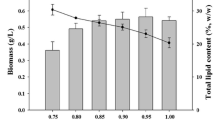Abstract
When Euglena gracilis was grown in the heterotrophic condition with glucose and (NH4)2SO4 as the carbon and nitrogen source, a high cell yield (4.28–4.48 g l−1) was obtained and the culture pH decreased to 1.6–2. The biomass production in the heterotrophic culture was compared to those in the autotrophic and mixotrophic cultures. Autotrophic growth was 4.7–6.3% of the heterotrophic one, whereas about 15–19% higher growth was obtained in the mixotrophic culture. Moreover, good production of chlorophyll (39.4 mg l−1) and carotenoids (13.8 mg l−1) were attained in the mixotrophic culture, giving the highest fermenter productivity with respect to biomass as well as chlorophyll and carotenoids. Through an energetic analysis in the mixotrophic culture, it was estimated about 25–28% of the total ATP requirement is formed in the photochemical reactions. This resulted in an improved biomass production in the mixotrophic culture of E. gracilis.
Similar content being viewed by others
References
Kitaoka S, Hosotani K (1977) Studies on culture conditions for the determination of the nutritive value of Euglena gracilis protein and the general and amino acid compositions of the cells. Nogeikagaku 51: 477–482 (in Japanese).
Kobayashi M, Kakizono T, Nagai S (1991) Astaxanthin production by a green alga, Haematococcus pluvialis accompanied with morphological changes in acetate media. J. Ferment. Bioeng. 71: 335–339.
Marquez FJ, Sasaki K, Nishio N, Nagai S (1995) Inhibitory effect of oxygen accumulation on the growth of Spirulina platensis. Biotechnol. Lett. 17: 225–228.
Nagai S (1979) Mass and energy balances for microbial growth kinetics. In: Ghose TK, Fiechter A, Blakebrough N (eds), Advances in Biochemical Engineering, Vol. 11. Springer-Verlag, Berlin, pp. 49-83.
Oda Y, Nakano Y, Kitaoka S (1982) Utilization and toxicity of exogenous amino acids in Euglena gracilis. J. Gen. Microbiol. 128: 853-858.
Orosa M, Franqueira D, Cid A, Abalde J (2001) Carotenoid accumulation in Haematococcus pluvialis in mixotrophic growth. Biotechnol. Lett. 23: 373-378.
Singh G, Chauhan VS, Ramamurthy V (1995) Kraft black liquor for improving the productivity of Spirulina platensis. Biotechnol. Lett. 17: 771-776.
Tabuchi T, Ueoka Y, Sigeoka S, Ohnishi T, Murakami T, Iizuka Y, Nakano Y, Kitaoka S (1984) Utilization of molasses on production of Euglena protein. J. Jpn. Soc. Nutr. Food Sci. 37: 525-534 (in Japanese).
Takeyama H, Kanamaru A, Yoshino Y, Kakuta H, Kawamura Y, Matsunaga T (1997) Production of antioxidant vitamins, β-carotene, vitamin C, and vitamin E, by two-step culture of Euglena gracilis Z. Biotechnol. Bioeng. 53: 185-190.
Yamaoka Y, Takimura O, Fuse H, Kamimura K (1994) β-Carotene production by Dunaliella salina in fed-batch and semicontinuous cultures under nutrient supplement. Seibutsu-kogaku 72: 111-114 (in Japanese).
Yokota A, Harada A, Kitaoka S (1989) Characterization of ribulose 1,5-bisphosphate carboxylase/oxygenase from Euglena gracilis Z. J. Biochem. 105: 400-405.
Author information
Authors and Affiliations
Corresponding author
Rights and permissions
About this article
Cite this article
Yamane, Yi., Utsunomiya, T., Watanabe, M. et al. Biomass production in mixotrophic culture of Euglena gracilis under acidic condition and its growth energetics. Biotechnology Letters 23, 1223–1228 (2001). https://doi.org/10.1023/A:1010573218863
Issue Date:
DOI: https://doi.org/10.1023/A:1010573218863




